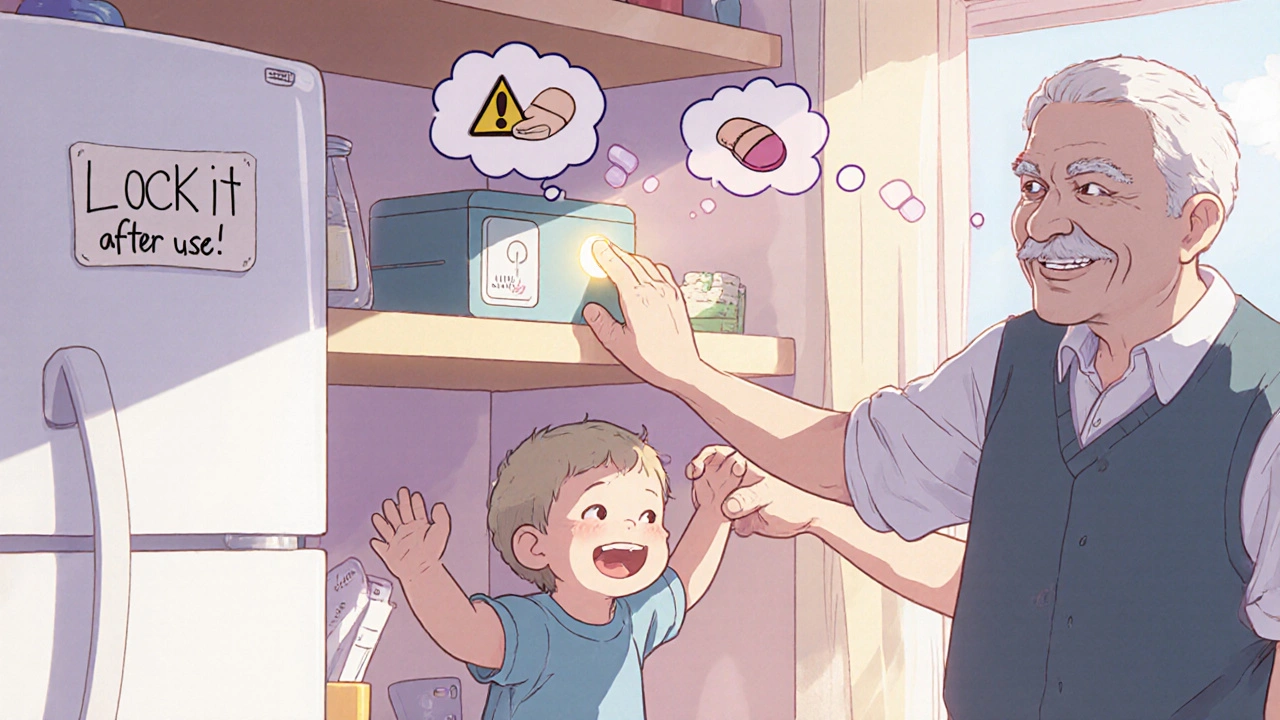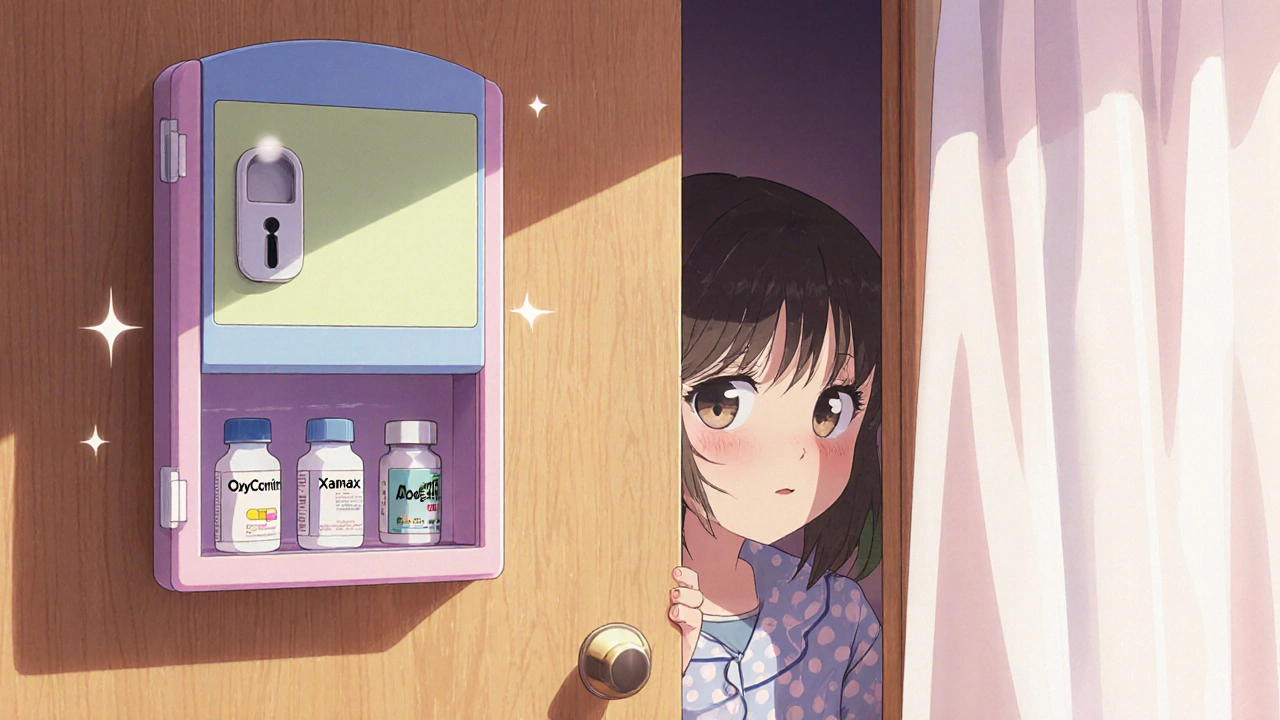Every year, around 60,000 children in the U.S. end up in the emergency room because they found and swallowed someone else’s medicine. Most of these cases happen at home - not in a pharmacy, not in a clinic, but right where you keep your pills: on the bathroom counter, in a nightstand, or tucked behind a cereal box. If you or someone in your home takes high-risk medications like opioids, benzodiazepines, or stimulants, storing them in plain sight is like leaving a loaded gun on the coffee table. The solution isn’t complicated, and it doesn’t cost much: a medication lockbox.
What Counts as a High-Risk Medication?
Not all pills need a lockbox. But if you’re taking any of these, you should consider one immediately:- Opioids: hydrocodone (Vicodin, Norco), oxycodone (Percocet, OxyContin), fentanyl patches
- Benzodiazepines: alprazolam (Xanax), diazepam (Valium), clonazepam (Klonopin)
- Stimulants: dextroamphetamine-amphetamine (Adderall), methylphenidate (Ritalin)
Why Child-Resistant Caps Aren’t Enough
You might think, “My pills are in child-resistant bottles - that’s safe.” But that’s not true. A 2021 study from OHSU found that 50% of kids aged 4 to 5 can open those caps in under a minute. They don’t need to be smart or strong. They just need to be curious. And they’re good at searching. A 2023 report from Hennepin Healthcare showed that 72% of children can find hidden meds within 30 minutes - whether they’re behind books, under socks, or taped to the underside of a shelf. Kids are detectives. They know where their parents hide things. And they don’t care about privacy - they care about what’s shiny, colorful, or tastes sweet. Lockboxes fix this. They’re not just containers. They’re barriers. No matter how clever a child is, they can’t open a locked box without the key, code, or fingerprint.Types of Lockboxes and What to Choose
There are three main types of medication lockboxes - each with pros and cons:- Key Locks: Simple, cheap (under $20), and reliable. You need to keep the key somewhere safe - not on the same shelf as the box. Best for homes with one or two adults who remember where they put the key.
- Combination Locks: No keys to lose. Usually 3- or 4-digit codes. Good for families, but if you forget the code, you’re locked out. Some models let you reset the code, but not all. Avoid if anyone in the house has memory issues.
- Biometric (Fingerprint): The most user-friendly. Touch the sensor, the box opens. Costs more ($30-$50), but worth it if you have elderly users or multiple people who need access. No codes to remember, no keys to misplace.
Where to Put Your Lockbox
Where you put it is just as important as what kind you buy. Here’s what works:- Best spots: Inside a bedroom closet, on a high shelf in a bedroom, or mounted on a wall with screws. Out of sight, but easy for authorized adults to reach.
- Avoid: Bathrooms (too humid, can ruin pills), kitchen counters (too visible), living room tables, or anywhere a child can climb to.

How to Set It Up - Step by Step
Follow this simple 5-step plan:- List all high-risk meds: Go through your medicine cabinet. Write down every opioid, benzodiazepine, or stimulant. If you’re unsure, ask your pharmacist.
- Choose your lockbox: Pick the type (key, combo, or fingerprint) that fits your household. Buy one that’s big enough to hold all your high-risk meds plus a little extra room.
- Install it: Mount it on a wall or place it on a high, stable surface. Keep it away from windows, heat sources, and moisture.
- Set access rules: Only two people should know the code or have the key - ideally, the person who takes the meds and one other adult. Never give the code to kids, teens, or visitors.
- Check monthly: Make sure the box is still locked. Make sure no one else has copied the code or found the key. Update your list if you get new prescriptions or stop taking one.
Real Stories - What Works
One mother on Reddit, u/MedSafetyMom, said her 3-year-old nearly got into her fentanyl patch. After installing a Master Lock Medication Lockbox, she said: “Eight months later, zero incidents. I sleep better now.” Another user, u/CaregiverAnne, cared for her 80-year-old father who struggled with combination locks. She switched to a fingerprint model for $35 more. “He opens it with one touch. No more yelling at me to help him remember the code.” A 2023 Consumer Reports survey of 1,200 households found that 78% of people who used lockboxes felt “much safer.” Only 22% said it was a little inconvenient - mostly because they forgot to lock it after use. That’s fixable with a reminder on the fridge or phone.What to Do in an Emergency
What if someone needs the medicine fast - like during a sudden pain flare-up? That’s a real concern. Solution: Keep a backup key or code with a trusted neighbor or family member who lives nearby. Tell them exactly where the lockbox is and how to open it. Write it down on a piece of paper and keep it in your wallet or purse. Don’t rely on memory. If you have a smart lockbox (like the new MediVault Pro), it can send alerts when someone opens it. That’s useful if you’re worried about misuse - but it’s not necessary for most homes.
What About Expired or Unused Meds?
Once you’re done with a medication, don’t flush it. Don’t throw it in the trash. Take it to a pharmacy drop-off box or a local drug take-back event. Many pharmacies in South Africa and the U.S. offer free disposal services. If you can’t get to a drop-off, mix the pills with coffee grounds or cat litter, put them in a sealed bag, and throw them in the trash. But only after you’ve removed them from the lockbox. Never leave expired pills inside.Why This Matters More Than You Think
This isn’t just about keeping kids safe. It’s about stopping addiction before it starts. Many people who become addicted to opioids first got them from a family member’s medicine cabinet. Teens who misuse prescription drugs often say they just took them “because they were there.” Lockboxes don’t just protect children. They protect your family’s future. In 2023, 22 U.S. states gave away free lockboxes through public health programs. South Dakota’s “Let’s Be Clear SD” program distributed over 10,000 boxes in three years. The federal government just allocated $15 million more in 2025 to keep giving them out. You don’t need to wait for a free one. A basic lockbox costs less than a dinner out. It’s cheaper than a hospital visit. And it’s the single most effective thing you can do to prevent a tragedy.Final Tip: Make It a Habit
After you install your lockbox, make a rule: every time you take a pill, you lock it back up. No exceptions. Even if you’re tired. Even if you’re in a hurry. Even if you think, “I’ll just leave it out for now.” That one habit - locking it after every use - is what turns a good idea into real safety. It’s not about being paranoid. It’s about being smart.Can I use a regular safe or gun safe for my medications?
Yes, but only if it’s easily accessible to the people who need the medication. Gun safes are often too heavy, too slow to open, or require a key you might forget. A dedicated medication lockbox is lighter, faster, and designed specifically for pills - with compartments to keep bottles upright and organized.
Do I need a lockbox if I don’t have kids?
Yes. Teens, guests, or even visitors with substance use issues can access unsecured meds. Over half of opioid misuse starts with pills taken from a family member’s cabinet. Lockboxes protect your medicine from being stolen or taken by accident - no matter who’s in your home.
Are lockboxes covered by insurance?
Most insurance plans don’t cover lockboxes yet. But some Medicaid programs and state health departments offer them for free - especially if you’re prescribed opioids. Check with your pharmacist or local public health office. In South Africa, some clinics provide them through HIV or chronic disease programs.
What if I forget the combination or lose the key?
Many lockboxes have a reset option - check the manual. If not, contact the manufacturer. Some brands send replacement keys or reset codes if you register your product. Avoid buying no-name brands without customer support. Stick to trusted names like Master Lock, MedSafe, or SafeKeeper.
Can I use a lockbox for over-the-counter drugs?
Yes - especially sleep aids, cough syrups with dextromethorphan, or pain relievers with codeine. These are often abused by teens. Even “safe” OTC meds can be dangerous in large doses. If you’re unsure, lock it up. Better safe than sorry.
